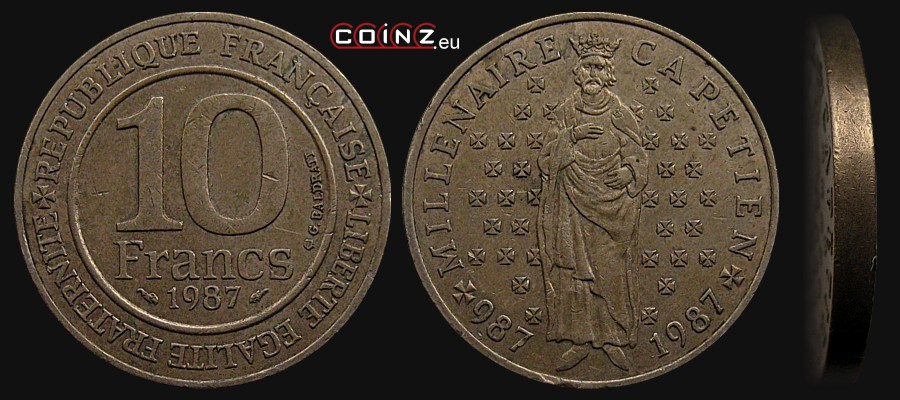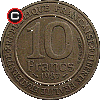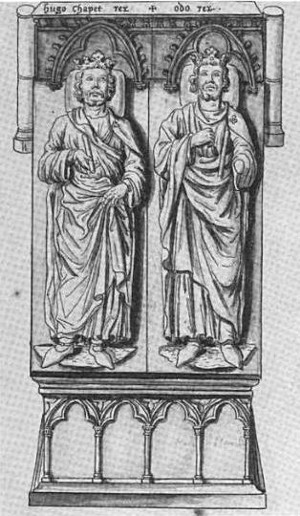10 francs FRANCE (1987) Millennium of Capetian Dynasty


| diameter: | weight: | thickness: | alloy: |
| 26.0 mm | 10.0 g | 2.6 mm | Cu92Ni6Al2 |
obverse:
in the coin centre in two lines face value: 10 / FRANCS, below year of issue 1987; all in a ring; along the edge: + REPUBLIQUE FRANÇAISE + LIBERTE EGALITE FRATERNITE (French Republic, liberty, equality, fraternity)
reverse:
in the coin centre figure of King Hugh Capet from the tomb sculpture en face; crosses in the background; along the top edge: MILLENAIRE CAPETIEN (millennium of the Capetians); along the bottom edge dates: 987 1987
edge:
plain
issue date:
??? no data
withdrawal date:
1 VII 1993
designer:
Atelier de gravure (group of designers of the Paris Mint - rosette after FRANCS in the obverse) based on design of Gérard Baldrati (signature G.BALDRATI after the rosette at the right edge of the ring in the obverse)
mint:
 La Monnaie de Paris (The Paris Mint), Pessac (mint mark before year of issue 1987 in the obverse, after year of issue privy mark of mint's director Émile Rousseau - dolphin)
La Monnaie de Paris (The Paris Mint), Pessac (mint mark before year of issue 1987 in the obverse, after year of issue privy mark of mint's director Émile Rousseau - dolphin)
mintage:
| 1987 | 19 948 451 | + 10 205 in annual boxed sets |
mint marks:
interesting facts:
The commemorative coin of 10 francs from 1987 was issued to celebrate the millennium that has passed since the coronation of Hugh Capet (Hugues Capet) - the first King of France of the Capetian dynasty. The reign of Hugh Capet took place in years 987-996 and his descendants still reign in Spain and Luxembourg.
The look of sculpture of King Capet placed on his tomb survived only on a drawing of François Roger de Gaignières (1642-1715). This became the inspiration for designer of coin reverse.

The look of sculpture of King Capet placed on his tomb survived only on a drawing of François Roger de Gaignières (1642-1715). This became the inspiration for designer of coin reverse.

last update: 20 XI 2013
coins catalogue :: katalog monet :: münzkatalog :: catalogue de monnaies :: catálogo de monedas :: catalogo monete :: каталог монет :: κέρματα κατάλογος :: COINZ.eu
© 2010-2025 :: Adam Kubicki :: COINZ.eu :: All rights reserved.


